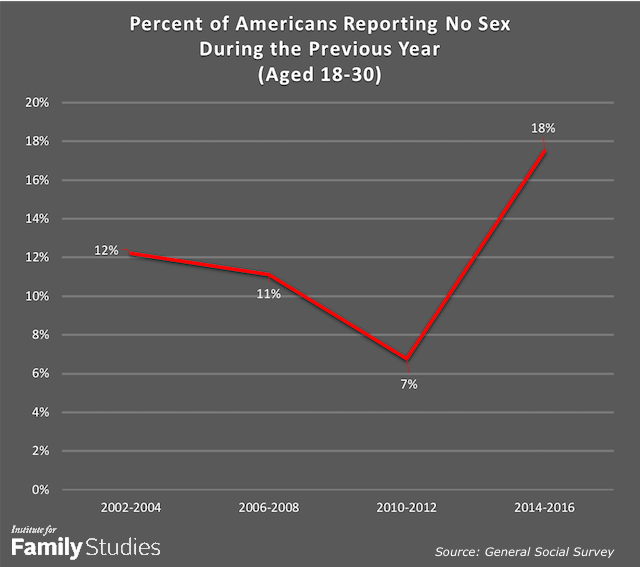Highlights
- The share of young adults who report having had no sex in the last year rose from about 12% in the early 2000s to 18% in 2014-2016. Post This
- The rise of smartphones and screen culture, from social media to porn, has cut into sex by making many forms of socializing, including dating, less common. Post This
Here’s a surprise just in time for Valentine's Day. Sex is down in America—especially among young adults and teenagers. As I note in a new article in Politico with Samuel Sturgeon, the share of young adults who report having had no sex in the last year rose from about 12% in the early 2000’s to 18% in 2014-2016. And the percent of adolescents who say they have had sex fell from 47% in 2005 to 41% in 2015, according to the Centers for Disease Control and Prevention.

What’s Driving the Decline in Sex?
We’re witnessing the rise of a “sexual counter-revolution,” says Douglas Murray at The Spectator, arguing “whereas the 1960s saw a freeing up of attitudes towards sex, pushing at boundaries, this counter-swing is turning sexual freedom into sexual fear, and nearly all sexual opportunities into a legalistic minefield.” According to this view, growing concern about the toll the culture’s approach to sex has taken on women’s lives is leading more and more young men and women to steer clear of it.
There’s something to this take, especially with the rise of the #MeToo movement. Workplaces, universities, and other institutions are taking a much tougher line on sex and dating—and plenty of people are adjusting their approaches to sex, dating, and mating. So, this is undoubtedly part of the story about the decline of sex, particularly if #MeToo accelerates the trend away from sex.
But it’s not the whole story. Another key aspect is the growing share of young adults living at home. Today, more young adults aged 18-34 live with mom and/or dad than a spouse, partly because they’re having a tough time getting established in today’s economy. Living at home, rather than with a husband or wife, puts an obvious crimp on a young person's love life.
However, Sturgeon and I do not think shifts in the economy and household arrangements, accelerated by the Great Recession, fully explain the decline in sex. That’s because the decline has deepened since 2012, even as the economy has been improving and the share of young adults living at home has leveled off. We think the rise of smartphones and screen culture—from social media to porn—has cut into sex by making many forms of socializing, including dating, less common. We put it like this: “evidence is growing that the spread of highly entertaining and diverting technology discourages in-person socializing, including—we think—one of the most fundamental forms of socializing—sex.”
In other words, the decline of sex among young adults in America may be driven, at least in part, by the fact that lots of them are spending more time with their smartphone rather than a special someone.
Read the full article in Politico.
W. Bradford Wilcox (@WilcoxNMP) is a senior fellow at the Institute for Family Studies and a professor of sociology at the University of Virginia.














